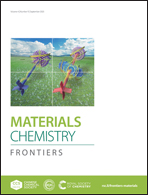Rapid synthesis of high-areal-capacitance ultrathin hexagon Fe2O3 nanoplates on carbon cloth via a versatile molten salt method†
Abstract
Earth abundant and environmentally benign iron oxides are ideal candidates for electrochemical energy storage. We report herein a rapid (within 1 min), facile one-step molten salt method to homogeneously coat various metal oxides of Fe2O3, Mn3O4, Co3O4, NiO, CuO, ZnO, etc. on carbon cloth (CC) for supercapacitor applications. In particular, ultra-thin Fe2O3 nanoplates coated on CC (Fe2O3@CC) connected in series to form a porous structure. Nanoplates have a larger specific surface area and hence more active sites for electrochemical reactions and the porous architecture effectively relieves the volume expansion of Fe2O3 during charging/discharging, which avoids the structural collapse and benefits the cycling stability. As a result, the Fe2O3@CC exhibits a large areal capacitance of 4175.7 mF cm−2 at a scan rate of 2 mV s−1 in −1.0–0 V vs. Hg/HgO, thanks also to the carbon cloth substrate activated simultaneously by the molten salt. The Fe2O3@CC electrode is especially appropriate for high current density (over 10 mA cm−2) charging/discharging. A Mn3O4@CC positive electrode is also synthesised via the molten salt method, and then coupled with the Fe2O3@CC negative electrode to assemble a 2 V high-voltage asymmetric supercapacitor (ASC) in 6 M KOH aqueous electrolyte. The Mn3O4@CC//Fe2O3@CC ASC delivers a high energy density of 2.91 mW h cm−3 at a power density of 25 mW cm−3 and a high power density of 278 mW cm−3 with a corresponding energy density of 1.25 mW h cm−3. An excellent cycling performance of 96% capacitance retention after 10 000 cycles at a high current density of 10 mA cm−2 is also recorded. The facile, versatile synthetic method and resultant high-performance electrodes are promising for practical applications in flexible electrochemical energy storage.



 Please wait while we load your content...
Please wait while we load your content...